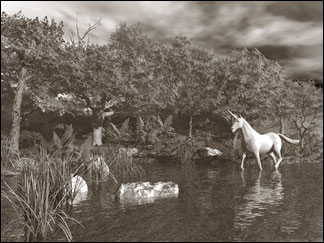Myth of Prince Diyasena
From yetis to unicorns, man's enthusiasm for myths is
undying:
by Sajitha Prematunge
[email protected]
|

Statue of Prince Diyasena
|
'Apage Diyasen Kumara wenuwen meduru thenewa....' went on one of my
favourite commercials - although I wouldn't call it a 'commercial' -
when my mother and father got in to a conversation about Diyasena
Kumaraya. Although I knew nothing about this Prince Diyasena, as myths
have had an affect on humans from time immemorial, it struck a cord.
Man's enthusiasm about myths is undying. From yetis, bigfoot,
unicorns to Nittaewo, some have in fact proven not so mythical. The myth
of Prince Diyasena or more widely known as Diyasena Kumaraya, is
believed to have originated in the Kotte era. One of the earliest known
records of Prince Diyasena comes in the Parakumba Siritha of the Kotte
era.
Kiyaga magiya, enu kohe sita, dada Samanala gosina
Noyathi yameku ediga? bamuna, Sumana surindu wisina
Giyakala dedahaspansiya rajeku ethei Diyana
Kiyawina thath wesiya, enam Parakum raja medina.....
Diya, here means the world and na means a King
This eulogy foretells - if I may still refer to it as that - that a
great King will be born in Sri Lanka after a lapse of 2500 years from
the birth of Lord Buddha, to preserve the culture and Buddhism of our
country.
The foretelling by God Sumana, to an ascetic - of the reincarnation
of King Parakumba, as a great King whose birth is to usher in all
possible wealth, prosperity and good health to Sri Lanka - marks the
origin of this folk lore.
After the 2550 Buddha Jayanthi, since no such saviours turned up, the
concept of a Prince Diyasena seemed to ebb. However it was not allowed
to totally erase from the minds of the people because of a certain ola
leaf that has provided vital evidence to support this theory, that
exists in the National Museum to this day. This ola leaf containing the
Sumana sutta was found from a temple in Algamuwa.
The ola leaf contains a history spanning from the arrival of the Lord
Buddha to the Dutch invasion.
The Sumana sutta, containing many folklore, was said to have been
preached by the Lord Buddha, when he came to Divaguha. But nowhere in
the Tripitaka is such a sutta mentioned. It's believed to have been
written during the Dutch invasion, when Buddhism and the country itself
was in decay.
Kotagama Wachissara Thero, in his book about the Saranankara
Sangharaja Era, states that the intension of the monk in proclaiming
that the Sumana Sutta was preached by the Lord Buddha himself, may have
been to pacify the lay and the ordained alike, at a time when Buddhism
as well as state affairs were subject to great deterioration.
The myth about Prince Diyasena surfaces and subsides with the times.
Whenever political instability effected the wellbeing of the people,
they start praying for a Prince Diyasena to deliver them.
Whenever a great change took place people tend to refer to the trend
setter as Prince Diyasena. Several politicians such as D.S. Senanayake,
S.W.R.D. Bandaranaike as well as Phillip Gunawardhane were referred to
as Prince Diyasena.
But the latest addition to this list are the three forces. Some
believe that the concept of Prince Diyasena is just wistful thinking,
that one day this reign of terrorism will be terminated by a saviour and
Sri Lanka will again be turned into a "Dhamma Deepa".
Even though the prediction is long overdue people still seem to hang
on to this myth that has a history of more than several hundred years as
people the world over hang on to their own versions.
****
Myth, legend, or fiction?
 Myth is derived from the Greek word mythos, which means "story." In
the academic fields of mythology, mythography or folkloristics a myth is
a sacred story concerning the origins of the world or how the world and
the creatures in it came to be in their present form. The active beings
in myths are generally gods and heroes. Myth is derived from the Greek word mythos, which means "story." In
the academic fields of mythology, mythography or folkloristics a myth is
a sacred story concerning the origins of the world or how the world and
the creatures in it came to be in their present form. The active beings
in myths are generally gods and heroes.
Myths often are said to take place before recorded history begins. In
saying that a myth is a sacred narrative, what is meant is that a myth
is believed to be true by people who attach religious or spiritual
significance to it. Use of the term by scholars does not imply that the
narrative is either true or false.
A myth in popular use is something that is widely thought to be
false. This usage, which is often pejorative, arose from labelling the
religious myths and beliefs of other cultures as being incorrect, but it
has spread to cover non-religious beliefs as well.
Because of this usage, many people take offense when the religious
narratives they believe to be true are called myths. This usage is
frequently confused with legend, fiction, fairy tale, folklore, fable
and urban legend each of which has a distinct meaning in academia.
A myth is something that is born from truth, but not necessarily 100%
true. Ancient peoples used myths to explain things usually in nature
that they could not understand. |
